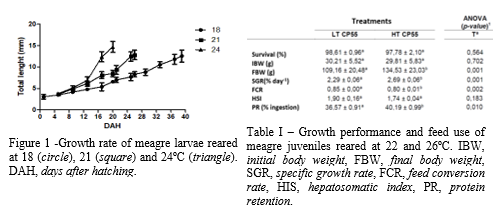ADVANCES ON MEAGRE Argyrosomus regius REARING: TEMPERATURE VS. PROTEIN, WHICH IS MORE IMPORTANT?
Introduction
Meagre (Argyrosomus regius) has been considered, in last decade, as one of the most promising fish species for aquaculture, in Mediterranean countries, and has even been described as the “Southern salmon” by some, due to its fast growing and processing potentials
.
Since 2009 several research projects have been developed, at the Aquaculture Research Station of Olhão (EPPO) , to address questions related to meagre rearing, including the capture in the wild , adaptation to captivity, breeding procedures, larval feeding protocol development and larval and juvenile rearing
. One of the most important questions raised along the years was the optimal rearing temperature for this species, and a lthough the normal spawning temperature rounds the 20ºC, the optimal rearing temperature , for larvae and juvenile, seems to be situated a couple degrees above , which makes meagre a suitable species to rear in recirculation systems (RAS), at higher and controlled temperatures . Another relevant question that has been addressed in trials conducted over the last years, was the optimisation of protein requirements for meagre farming.
In this work we present an overview of the trials conducted on meagre, tackling optimal protein and temperature requirements for this species.
Materials and methods
M eagre breeders were kept in 10m3 or 50m3 tanks in a flow through water system with controlled temperature, constant aeration, under a regime of 10 h light:14 h dark. Fish we re manually fed ad libitum , with a commercial feed (SPAROS) and supplemented every two days with frozen seafood (mackerel and squid). Larval trial: eggs were distributed immediately after hatching in 250L tanks , with a density of 1 larvae/L . Temperatures were kept at 18, 21 and 24 ºC. Fish were fed ad libitum , with a commercial diet (Caviar®, BernAqua) until they reach 12mm. Growth and su rvival parameters were taken daily and s amples for larval ontogeny, IGF1 exp ression and digestive enzymes were collected; Post-larval trial : f ish were distributed at the density of 1 fish/L in 300 L tanks . Temperatures were kept at 20 and 24 ºC and fish were fed ad libitum with a commercial diet (SPAROS) . Biometric samplings took place every five days and density was adjusted to 1.5 Kg/m3 , except for the final sampling, that occurred when the fish reach the density of 5 Kg/m3 . Fish size dispersion was accessed and samples for IGF1 gene expression, histology and microbiology were collected. For the juvenile trials fish were distributed in homogenous groups (triplicates) in tanks of 1500L: 1) t emperature of the tanks were kept at 20 (LT) and 24ºC (HT) and fish from the two groups were fed, ad libitum 3x a day, with isolipidic diets containing either 48 (LP) or 52% (HP) of protein (SPAROS) until doubling their initial weight; 2) temperature of the tanks were kept at 22 (LT) and 26ºC (HT) and fed , ad libitum 3x a day, with isolipidic diets with different protein content and origin: CP50 (24.5% fish meal – FM – and 25.5% vegetable origin proteins – VP), CP55 (28% FM and 27% VP) and CP55 ALT ( 7% FM, 21% VP and 27% poultry meal – PM) (SPAROS) , combined in 4 treatments (LTCP55, HTCP50, HTCP55 and HTCP55 ALT) . Both juvenile trials were conducted until fish doubled their initial weight. Growth parameters, survival and feed conversion rate were calculated and samples for fatty acids, gene expression, skeletal development and histology, were collected.
Results and Discussion
For both larvae and juveniles, it was shown that the optimal rearing temperature for meagre is around the 24ºC with fish presenting a fast growth at this temperature (Figure 1). Additionally , a higher rearing temperature had no negative impact on the normal development , with fish presenting a proper external morphology and organ development.
S pecific growth rate (SGR) and protein efficiency ratio (PER) were significantly higher in the HPHT treatment with the higher temperature (24ºC) promoting feeding ingestion (Table I) . The p rotein increase in the diet showed a tendency for fish protein retention with that not being affected by a lower temperature. Fatty acids content in the liver was not affected by the temperature nor the protein, however there is a decrease on muscle lipid content in the LTHP treatment. These results showed that growth and feeding efficiency were maximized at higher temperatures and that temperature is prevalent over the source and protein content in the diet, as fish growth performance was not affected by these factors when reared at higher temperatures (Table I).
References
1. Ribeiro, L. et al. Effect of vegetable based diets on growth, intestinal morphology, activity of intestinal enzymes and haematological stress indicators in meagre (Argyrosomus regius). Aquaculture 447, 116–128 (2015).
2. Califano, G. et al. Molecular taxonomic profiling of bacterial communities in a gilthead seabream (Sparus aurata) hatchery. Front. Microbiol. 8, (2017).
3. Saavedra, M. et al. Amino acid profiles of meagre (Argyrosomus regius) larvae: Towards the formulation of an amino acid balanced diet. Aquaculture 448, 315–320 (2015).
4. Cardeira, J. et al. Osteology of the axial and appendicular skeletons of the meagre Argyrosomus regius (Sciaenidae) and early skeletal development at two rearing facilities. J. Appl. Ichthyol. 28, 464–470 (2012).
5. Barata, M. et al. Efficiency of 2-phenoxyethanol and Clove Oil for Reducing Handling Stress in Reared Meagre, Argyrosomus regius (Pisces: Sciaenidae). J. World Aquac. Soc. 47, 82–92 (2016).
6. Soares, F. et al. Comparative analysis on natural spawning of F1 meagre, Argyrosomus regius, with wild broodstock spawns in Portugal. Fish Physiol. Biochem. 41, 1509–1514 (2015).
Aknowledgments
The research was funded by DIVERSIAQUA II project (Mar2020-P02M01-0656P ), Leticia Lujan is the recipient of a fellowship funded by the European Union’s Horizon 2020 research and innovation programme under the Marie Skłodowska-Curie grant agreement No. 766347.
